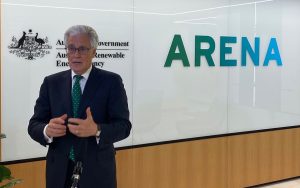Detail plus vision: Australia’s industrial decarbonisation report
Three years in the making, the third and final report from the Australian Industry ETI attracted a slice of renewable energy names to its launch event in Sydney.

“If you can do it in Australia, you can do it in the world.” – Energy Transitions Commission Chair Lord Adair Turner
You could hardly move for Chairpersons, corporate executives, visiting nobility and, of course a federal climate change minister at the launch event for the third and final report from the Australian Industry Energy Transitions Initiative (Australian Industry ETI), Pathways to Industrial Decarbonisation.
And with good reason.
The report maps a potential pathway for Australia to cut annual greenhouse gas emissions in five key industrial sectors by 92 per cent by 2050. In context, the report says heavy industry is collectively responsible for more than 25 per cent of Australia’s annual emissions.
The ambitious but credible pathway would also position Australia’s industries in line with limiting global warming to 1.5 degrees.
Australian Industry ETI Chair Simon McKeon described the report as being of “considerable national significance”.
“I think for the first time, it’s being said in this country that from an industry perspective, it is possible to largely decarbonise,” he said
“The best brains in the country, including CSIRO and other advisors have been part of this work,” he said.
“The true value of this initiative is in the benefits of the collaboration.” – ARENA CEO Darren Miller
Two not-for-profits, Climateworks Centre and Climate-KIC Australia, authored the report. It is the third in a series of three, supported by ARENA funding worth $2.3 million since 2020.
The report says the gains for Australian industries by following a “coordinated action scenario” would dwarf the costs. Altogether those costs could average out at more than $20 billion annually for 30 years.
But it would leave Australian green industries with competitive advantages, new export sectors, continuing share in existing markets and create up to 1.35 million jobs.
Renewable energy powerhouse

Minister for Climate Change and Energy, Chris Bowen highlighted the opportunities for heavy industry.
“We’re not going to achieve our targets unless we have a proper framework to get those emissions down,” he said.
“That’s important both in terms of challenges but also, I think in terms of opportunities.
“We are a great industrial powerhouse of a nation, we’re an energy superpower. And we will continue to be a powerhouse but that will increasingly become a renewable energy powerhouse,” he said.
But to get there, Australia’s energy generation and use will have to undergo a transformation, said Climateworks CEO Anna Skarbek.
“It is achievable in Australia through electrification, energy efficiency and the use of green hydrogen to substitute for other fossil fuel sources,” she said
“This involves at least a doubling of electricity generation, or more than double again when we include exports, and vast scaling up of renewable energy.”
Detail plus vision

Guest speaker Lord Adair Turner – or simply Adair to his friends – is an international figure in the renewable energy sector.
Chair of the Energy Transitions Commission, a global coalition of major power and industrial companies, investors, environmental NGOs and experts, he attended the ETI report launch event during a multi-country trip to meet with major industrial players.
“The level of detail [in the report], the nitty-gritty engineering detail working through technology by technology, is very important,” he said.
“But what this report also does is combine that with vision. A vision that is how Australian heavy industry can get to net zero by 2050.
Other reports produced around the world have examined these same issues. But Lord Turner emphasised how the Pathways to Industrial Decarbonisation report could help realise what he called: “A revolution of ambition across the world in these hard to abate sectors.”
“What this report provides is a detailed roadmap, based in detailed understanding of the technologies and the actual engineering of how you do it in Australia. And if you can do it in Australia, you can do it in the world,” he said.
Benefits of collaboration
Reflecting on the project’s achievements, ARENA CEO Darren Miller thanked contributors and partners, saying: “ARENA is very proud to have supported this initiative right from the early days back in 2020.”
“The true value of this initiative is in the benefits of the collaboration you have all experienced in the past few years,” he said.
“We’ve worked closely with many of you over the years, with BP, BlueScope, Fortescue, Rio Tinto just to name a few. And we look forward to supporting you in the years ahead, as we all join together to make this a reality.”
LIKE THIS STORY? SIGN UP TO OUR NEWSLETTER

ARENA